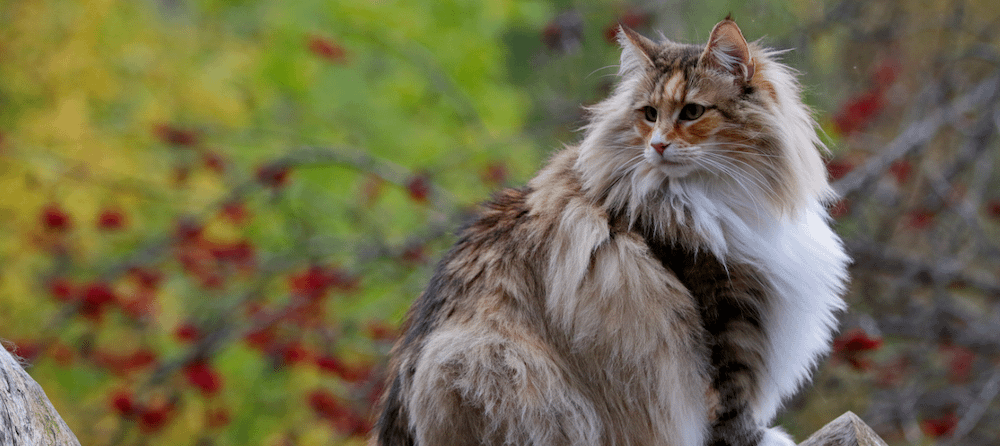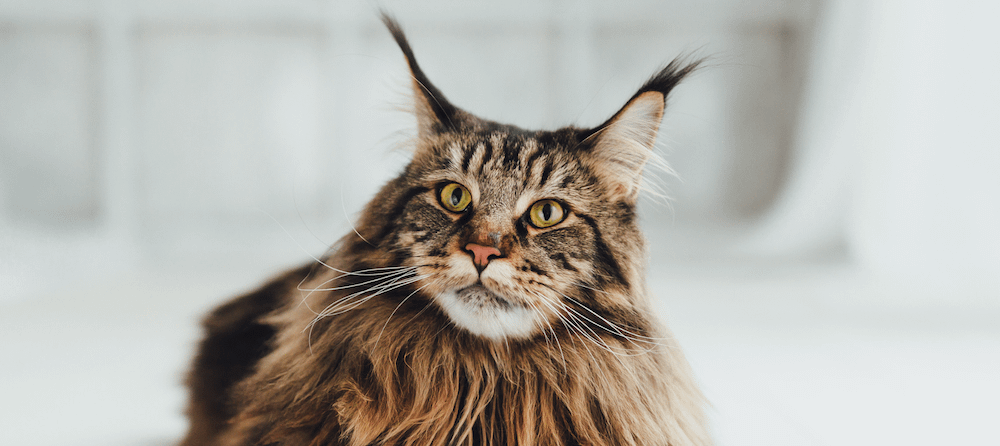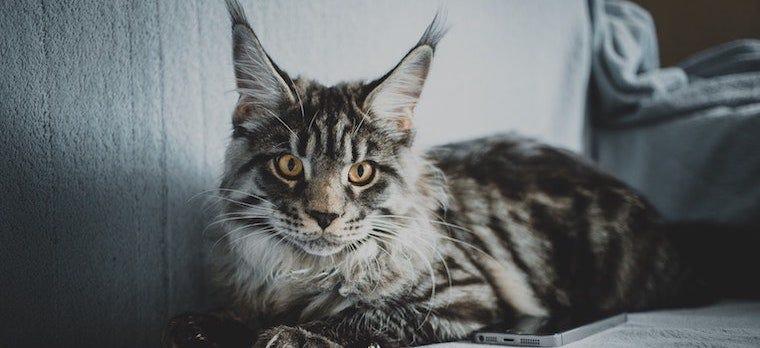The Norwegian Forest cat is a stunning, strong-boned, semi-long-haired domestic cat breed native to Norway. These Scandinavian cats stand out with their rugged appearance and size. In addition to their sturdy bones, the thick hair of their long coat and a bushy tail makes the Norwegian Forest cat appear even bigger, resulting in one of the largest domestic cat breeds.
| Norwegian Forest cat | ...at a glance |
|---|---|
| Personality | Adaptable, laid-back, independent |
| Life expectancy | 12-16 years |
| Weight | 8-20 lbs |
| Coat & colors | Semi-long, dense; various colors & patterns |
| Energy level | Medium |
| Affection level | Medium |
| Friendliness | High |
| Shedding level | Medium |
| Required grooming | High |
Overview of the Norwegian Forest cat
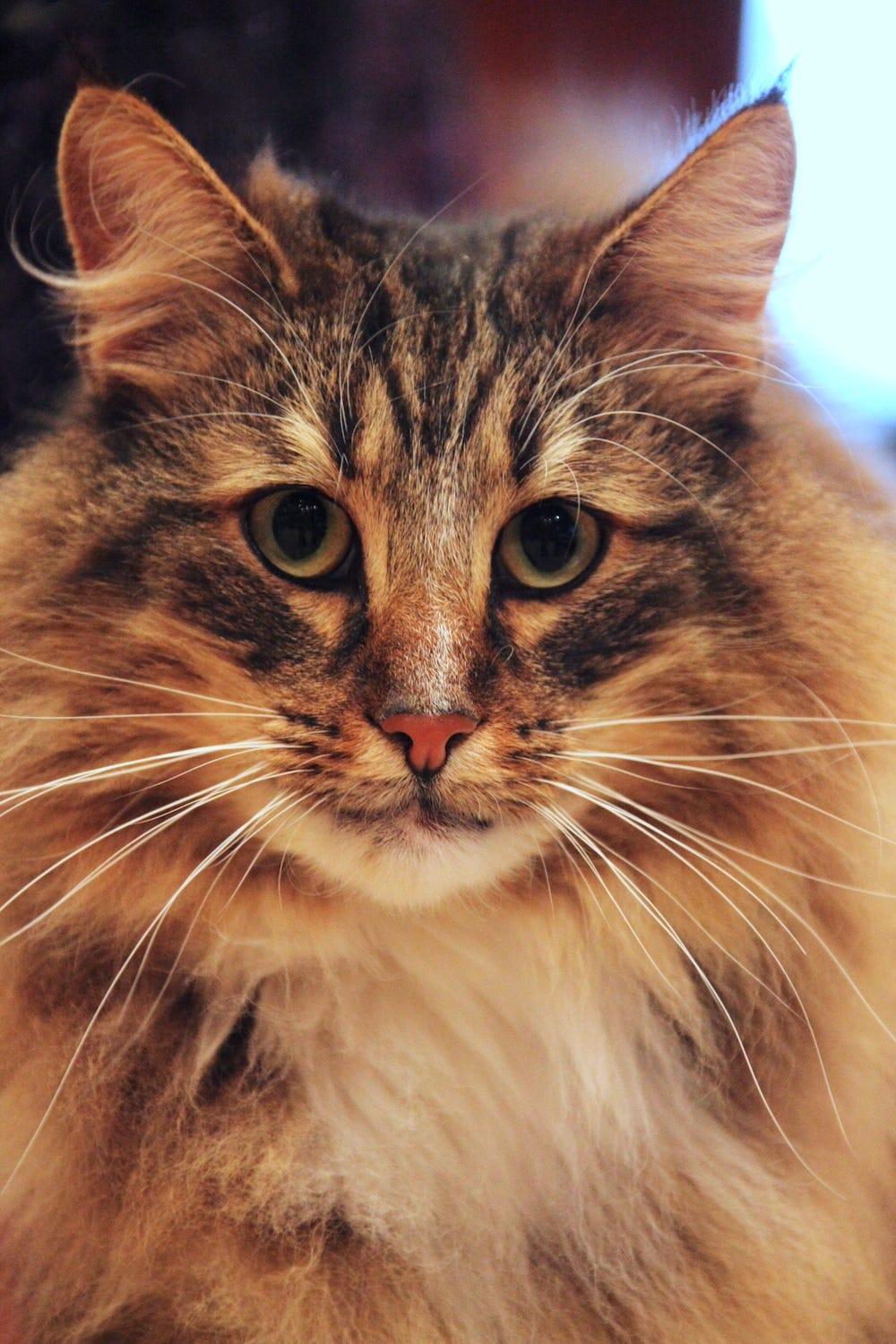
These cats are overall laid-back, which is a key reason why they’re such a popular breed. A friendly cat that isn’t in constant need of attention, the Norwegian Forest cat is an incredible companion breed. These cats can work well within big families because they are adaptable and patient with children. If you want a cat that will be tolerant and impactful in your family, they are a great choice.
Learning about the cat breed you hope to one day welcome into your home can help you prepare for many years of care and nurturing. Having a Norwegian Forest cat is a big responsibility, especially for first-time cat parents, but it truly pays off in the loyalty that they give. Because these cats are so large with luscious coats, it's important to be prepared for how to properly care for them.
Weight
The Norwegian Forest cat is larger than the average domestic cat breed. They are a sturdy breed with a very muscular body, which helped them to thrive in the wild for centuries. Now their strength is used to pounce on lasers, climb cat trees, and chase after gleeful children.
A typical male Norwegian Forest cat weighs between 12 and 20 pounds, while a female Norwegian Forest cat weighs between 8 and 16 pounds, meaning they are about 30% bigger than the average house cat.
This large breed is a bit slow to mature and won’t be full-sized until they are 5 years old.
Length
The Norwegian Forest cat ranges in length, but their bodies and tails are often very similar in size. They also have long muzzles and long legs; they easily stand out from their feline peers. Typically, they range from 12 to 18 inches long, and some easily surpass that.
Coat
Like other winter cats, the Norwegian Forest cat has semi-long hair that is thick, soft, and warm enough to survive the cold climate of Northern Europe. These cats have a double coat: a thick, dense undercoat and a glossy, water-resistant top coat.
Nearly every color and pattern known to cats can be presented in the Norwegian Forest cat, other than colors resulting from hybridization. Their thick and water-repellent coats require regular grooming to properly maintain.
Life expectancy
Norwegian Forest cats generally have a lifespan between 12 and 16 years. To better understand your cat's age in relation to human years, you can check out our article about cat age in human years. Ultimately, this is a cat that will see you through major life events. They will stick by your side for years to come as long as you keep up their care.
History of the Norwegian Forest cat
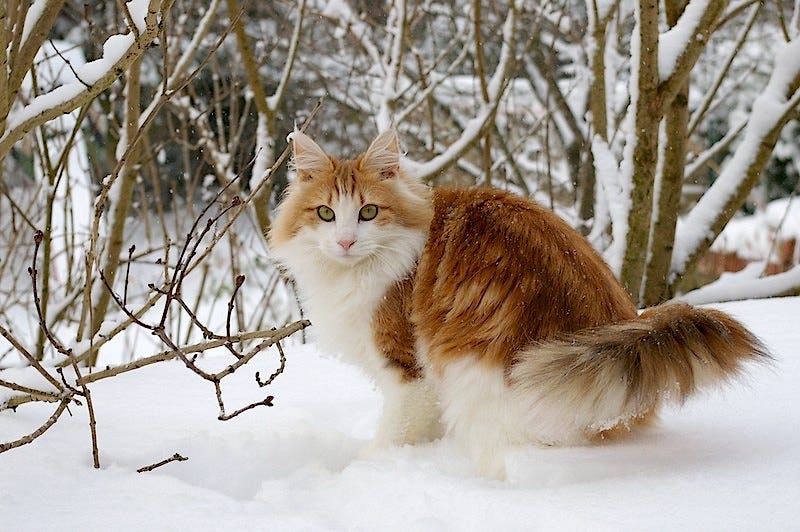
Known as the skogkatt (which means forest cat or fairy cat) in Norway, the Norwegian Forest cat came from, you guessed it—the Norwegian forest! This breed carries history and magic with them, dating back hundreds of years. While this breed might appear to be unruly and feral, they do not come from a line of wild cats. Instead, they most likely descended from cross-breeding with domestic cats that were brought to Europe by the Romans.
Norse mythology tells many stories about long-haired forest cats that knew more about people than people knew about themselves. Norwegian Forest cats exude magical energy. They traveled with the Vikings, usually working as mousers and keeping their ships and villages free of vermin. The Norse goddess Freya was said to drive a chariot pulled by two giant cats.
While much is unknown about their history, it’s likely that shorthaired cats made their way into Europe more than a thousand years ago and learned to adapt to the harsher climates, producing long-haired kittens that could better withstand the cold. To survive in a rough climate, the skogkatt learned to be resilient and quick-witted, which has carried over into the domestic Norwegian Forest cats of today.
Into the modern era
Norwegian Forest cat fans had to work hard to preserve the breed, as they almost came to extinction in the 1930s due to hybridization with local free-roaming Domestic Shorthairs in Norway.
After World War II, reputable breeders and admirers of the Norwegian Forest cat were able to save the breed through a careful breeding program. Thanks to the crusades of these cat breeders, Norwegian Forest cats were granted full championship status in the European show ring and elected the official cat of Norway in the 1950s, thanks to King Olav.
They first stepped foot in the United States in 1979. (Though they might have crossed the Atlantic with Leif Erikson around 1000 AD—we'll never know for sure!) Since their recent reintroduction to North America, they have become a very popular cat breed in all corners of the world.
Characteristics
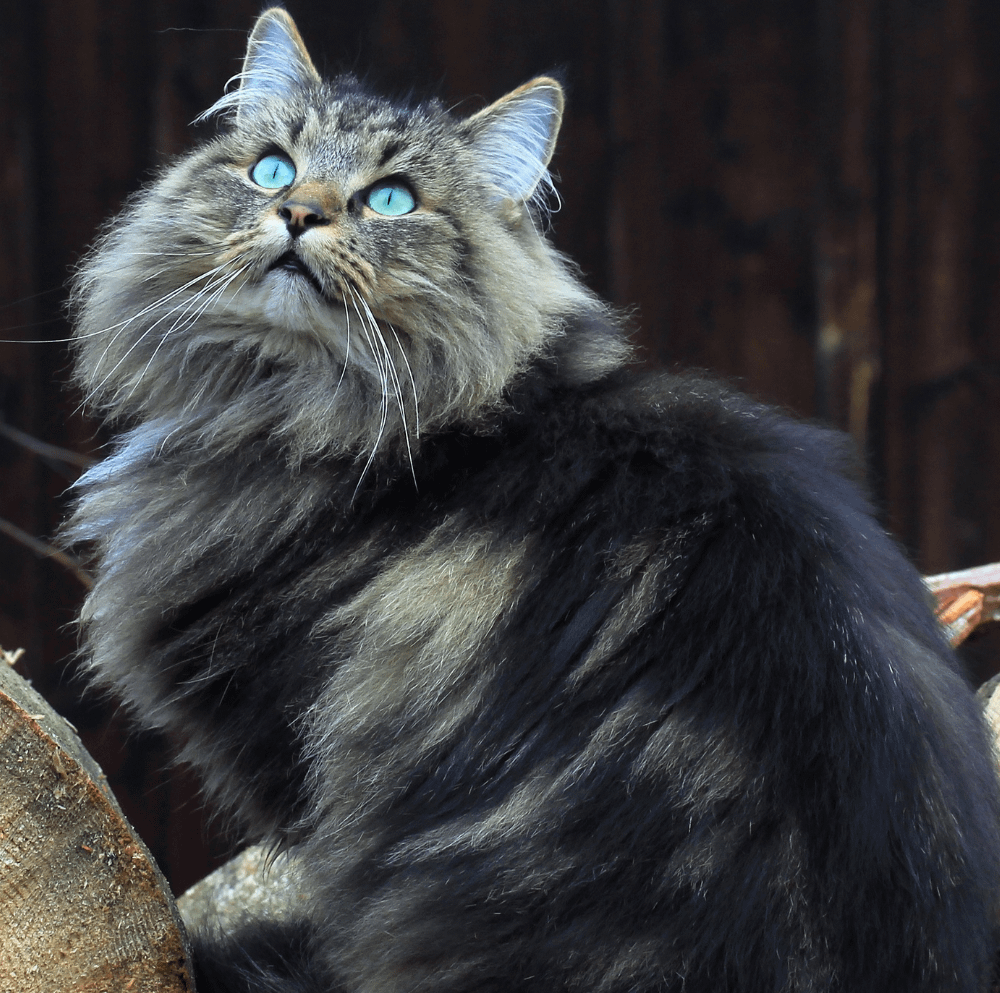
What is most notable about the Norwegian Forest cat is their large bodies and long hair. They can have a variety of coat colors, making each Norwegian Forest cat unique. The most common color pattern is tabby and white. As beautiful as their coats are, they need to be groomed and maintained frequently.
Some color and pattern variations include solid colors (white, black, blue, cream, red, smoke, lavender, and chocolate), calico, and tortoiseshell. Their eye color can vary.
These cats are strong with a powerful appearance. Every part of their body is muscular and broad, adding to their large size. Even their paws, arms, hind legs, and ears are on the larger side, allowing them to move quickly and stay alert at all times. Their ancestors might have braved forest winters, but the modern Norwegian Forest cat is more than happy to be living a life of luxury.
Personality
The Norwegian Forest cat personality is typically very warm. This is a gentle, friendly companion that is capable of love and independence in equal measure. They are highly adaptable, which might come from their years of wandering the Norwegian forests.
The Norwegian Forest cat enjoys being around people and is not easily frightened by newcomers. Once they have accepted you as their human, they will protect you endlessly. It’s in their nature to watch over the house, and so you might notice your cat patrolling the parameters of the house a few times a day.
Despite their independent streak and protective nature, they appreciate the warmth of a good cuddle and the company of their loved ones. They like to cozy up with their human companions and enjoy being part of family activities. They also love to play with toys and need to have moderate activity throughout the day. If you want a cat that is affectionate while also relatively laid-back, then this is the kitty for you.
What’s the difference between Norwegian Forest cats and Maine Coons?
These two breeds are often confused for one another. While both the Norwegian Forest cat and the Maine Coon cat are large, long-haired breeds, there are a few key differences between them.
Aesthetics
Physically, Maine Coons typically have a squarer muzzle compared to the triangular face of the Norwegian Forest cat. Maine Coons often display distinctive ear tufts (also known as lynx tips), although Norwegian Forest cats have their share of ear furnishings as well.
Personality
In terms of personality, while both breeds are friendly and sociable, Norwegian Forest cats are generally more independent and less demanding of attention compared to Maine Coons. Maine Coons are known to be exceptionally playful and require more interactive playtime, while Norwegian Forest cats are content with a moderate level of activity and can entertain themselves.
Ultimately, both breeds make wonderful pets, but your choice between the two might come down to whether you want a more independent companion in the Norwegian Forest cat, or a more attention-seeking and playful companion in the Maine Coon.
Caring for a Norwegian Forest Cat
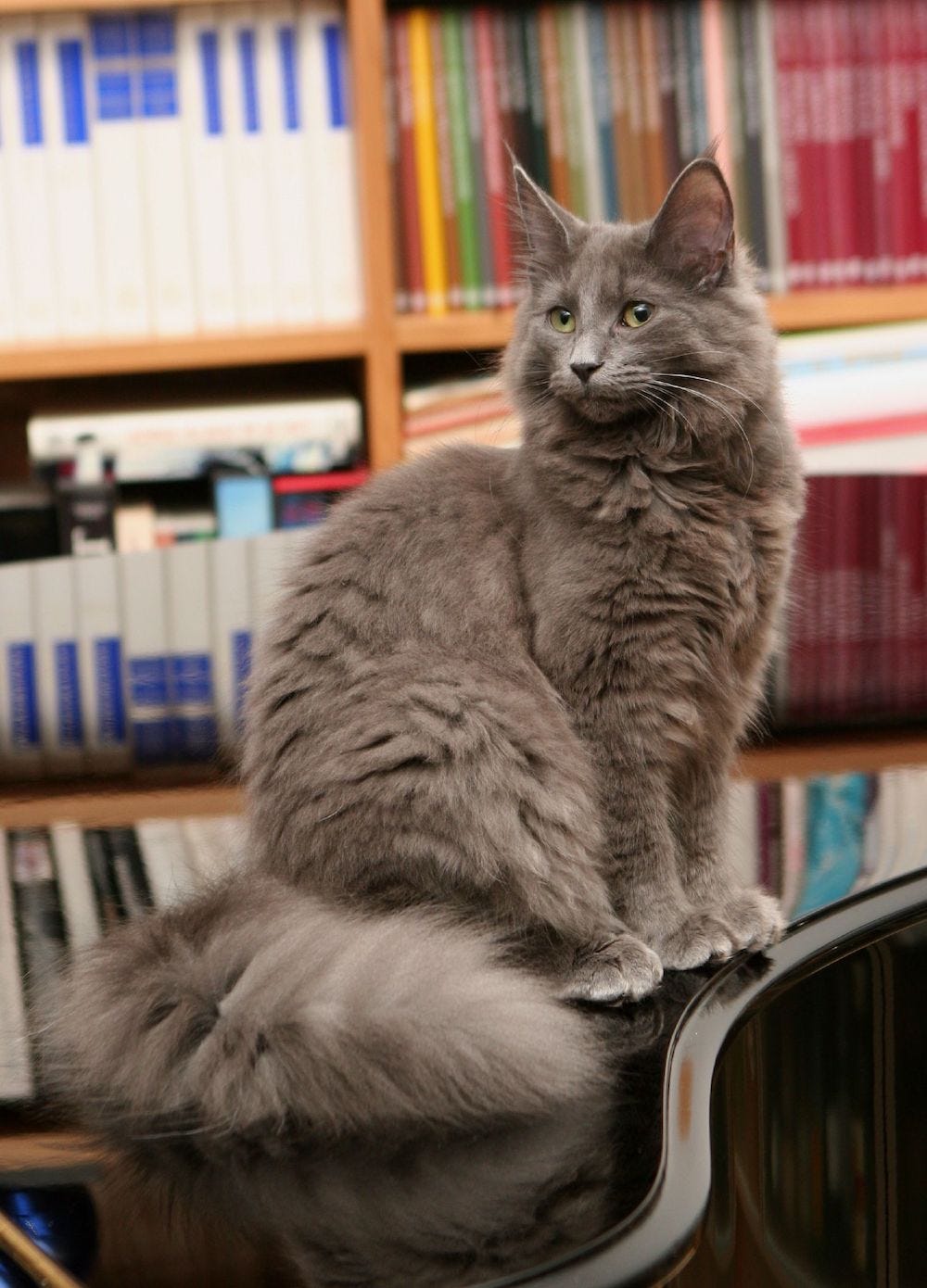
You will need to provide adequate exercise and mental activity to keep your pet happy and stimulated. Luckily Norwegian Forest cats are good at entertaining themselves, so finding the middle ground is quite easy.
You should have a cat tree and scratching post available to your Norwegian Forest cat because they love hunting and making their home into a playhouse. (After all, these longhaired cats' ancestors were said to climb sheer rock with ease.)
To keep up with proper grooming for a Norwegian Forest cat, you should be brushing their fur weekly—or daily, during shedding season. This can help avoid knots and tangles as well as prevent hairballs. Grooming can even become a part of playtime to make it enjoyable for your cat and easier for you.
Norwegian Forest cats are very particular about their bathroom location, so you will want to make sure you keep a clean litter box that your cat can access easily throughout the day. A self-cleaning litter box like Litter-Robot may be just what you need.
Norwegian Forest cat health concerns
Norwegian Forest cats are known for being resilient and strong, which means they usually end up with a good bill of health. However, they are prone to certain health issues that you’ll need to be on the lookout for so your “Wegie” can live a happy and healthy life.
Hypertrophic cardiomyopathy is the most common form of heart disease found in cats, and sometimes arises in Norwegian Forest cats. This condition causes the muscular walls of a cat’s heart to thicken, which lowers the ability of the heart to function properly.
Besides heart disease, these cats are also prone to kidney disease and hip dysplasia (a hereditary condition of the hip joint). Regular veterinary check-ups, blood tests, echocardiograms, and hip evaluations are crucial for early detection of these health conditions.
It’s good to be prepared for some of these issues, but it’s important to note that the Norwegian Forest cat is a very strong-willed feline! With the right care and attention, Norwegian Forest cats can live a long and healthy life despite these potential health issues.
Adopting a Norwegian Forest cat
Finding the right cat for you is about learning what you want out of the companionship. If you want a cat that is loyal, protective, intelligent, and friendly, the Norwegian Forest cat checks all the boxes. As large as they are, they find a way to adapt to any home and make for amazing family pets.
Everyone will fall head over heels for your Norwegian Forest cat!
Sources:
- Hypertrophic Cardiomyopathy | Cornell University College of Veterinary Medicine
- Freyja | Britannica
- Norwegian Forest Cat — Full Profile, History, and Care | The Spruce Pets
Photo credits:
- © Gangburgondes / CC-BY-SA-3.0
- © Pieter Lanser / CC-BY-SA-2.0
